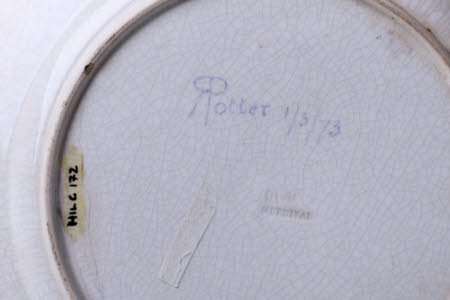Plate
Rupert William Potter (1833–1914)
Category
Ceramics
Date
1873
Materials
Earthenware and paint
Measurements
233 mm (Diameter)
Order this imageCollection
Hill Top, Cumbria
NT 641536
Summary
Plate, earthenware, made by Thomas Furnival or Thomas Furnival & Sons, Cobridge, Staffordshire, decorated by Rupert Potter, 1 March 1873; printed in blue on a white ground with the image of a wren on a branch, border pattern of trailing ivy, brown enamelled edge to rim.
Full description
Until she bought Hill Top in 1905, aged 39, Beatrix had lived a stone’s throw from the Victoria and Albert Museum (V&A) and Natural History Museum at her family home, 2 Bolton Gardens, in South Kensington. Beatrix’s creative energy was encouraged by her father, Rupert Potter (1832-1914). Rupert trained as a barrister but didn’t practice the law, instead spending time networking with artists, writers and politicians. He was also a talented photographer and loved to sketch. Beatrix’s brother, Bertram (1872-1918), was a professional engraver and landscape painter before becoming, like Beatrix, a farmer. Beatrix undertook formal private art lessons from a young age and the family used Vere Foster's Drawing Copy-Books at home. There were many iterations of this publication, which focussed on an enormous variety of subjects including birds and animals, landscapes, flowers, household objects and the human figure. The books included blank papers for copying the printed illustrations and were aimed at helping to improve basic drawing skills. The collection of the V&A includes a number of ink drawings of birds and animals signed by both Rupert and Beatrix, copied directly from the Vere Foster books. Not satisfied with merely copying the images, the Potters experimented with turning their blue ink drawings into prints on linen, probably by lifting off an imprint from the wet ink drawing using a gelatine bat and placing it onto the textile (e.g., V&A AR.4:374-2006). Some of these drawings were adapted into ceramic transfer prints seen, for example, on a pair of tiles converted into pot stands at Hill Top, signed by Beatrix and dated to February 1881 (NT641377.1-2) There are a number of repeats of the group of rabbits with upright ears in the collection at the V&A that are the correct scale for the tile – it was an image that Beatrix clearly really liked (e.g., V&A P.560B, drawn in 1880). Rupert had already decorated a lovely group of plates for Beatrix and Bertram’s nursery at Bolton Gardens that are now prominently displayed in the entrance at Hill Top. They were made with plates by Thomas Furnival of Cobridge in Stoke on Trent, which is known to have supplied blanks for amateur decorators. The plates are signed by Rupert and a few are also dated to 1872 and 1873. Like the pot stands, some of the images were taken from Vere Foster’s drawing books. This plate is printed with the image of a wren taken from Vere Foster’s Drawing Book O3, on Small British Birds. In the original image, the wren is sitting on a rock, but Potter has placed it onto a branch. There are numerous versions of the image printed onto linen by Rupert Potter in the V&A collection, showing the bird on a different form of branch (e.g., AR.4:361-2006). The plate also has a hand drawn border pattern. Rupert’s plates and Beatrix’s pot stands are printed, not hand painted and the prints sit under the glaze, so the Potters presumably knew someone who could glaze and fire them, or sent them to a factory to be finished. The amateur decoration of ceramics was an incredibly popular polite pastime during the late nineteenth century, so the Potters will have had access to commercially available mineral pigments or pre-mixed paints needed for decorating the plates.
Marks and inscriptions
Underside of base: FURNIVAL 16 (impressed mark) 'RPotter 1/3/73' (hand painted) '
Makers and roles
Rupert William Potter (1833–1914), artist after Harrison William Weir (Lewes 1824 - Appledore 1906) , artist
References
Conroy 2023: Rachel Conroy, ‘A love of ‘old china, especially earthenware’: ceramics at Beatrix Potter’s Hill Top and in her ‘little books’, Transactions of the English Ceramic Circle (Volume 34, 2023), 95-112

